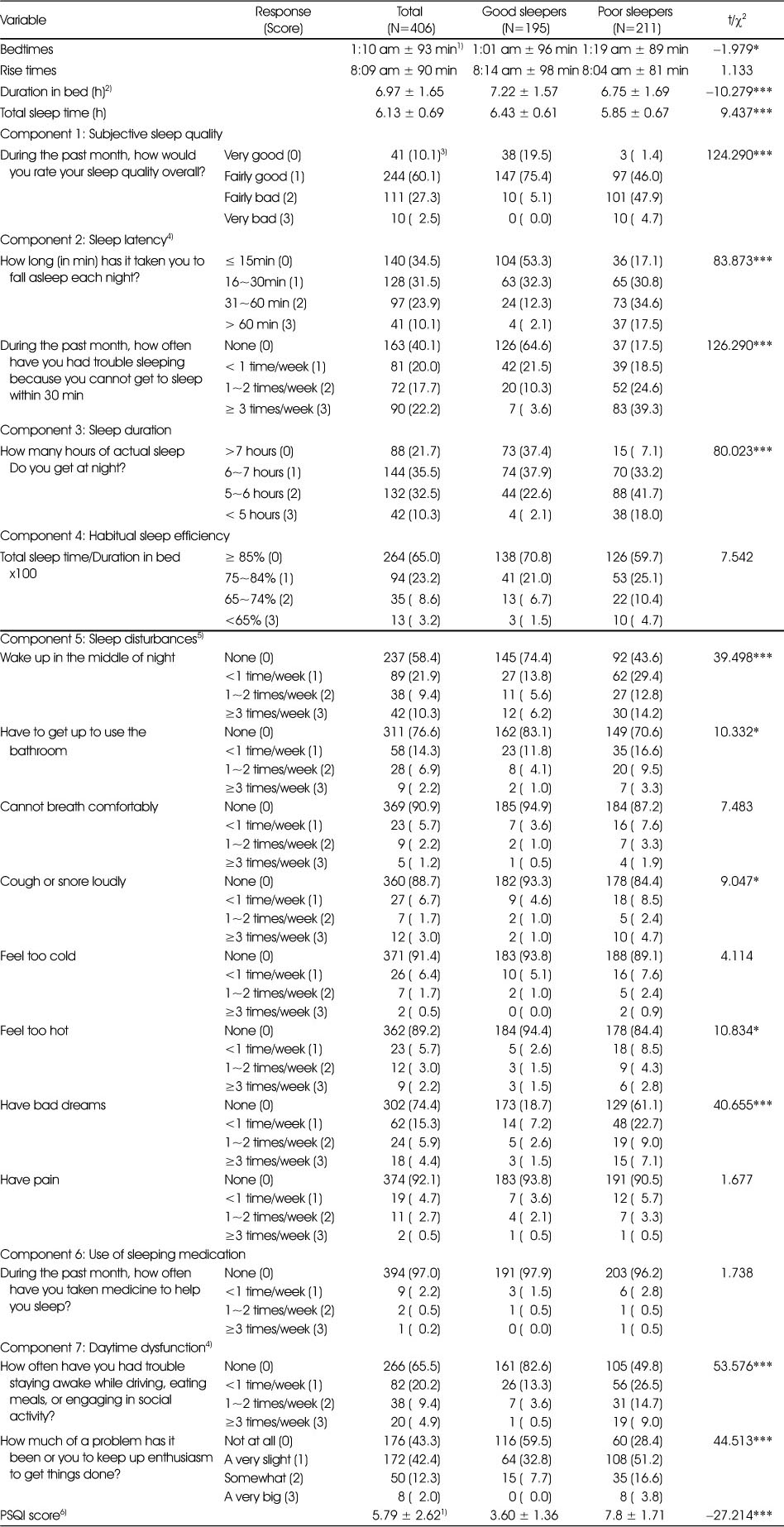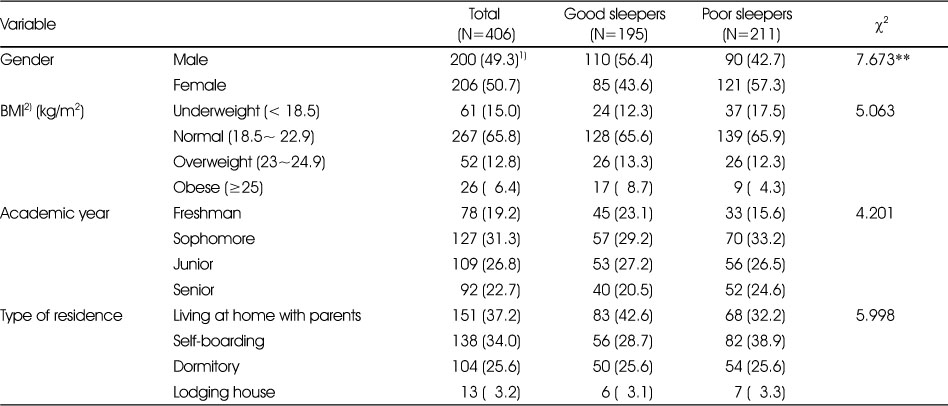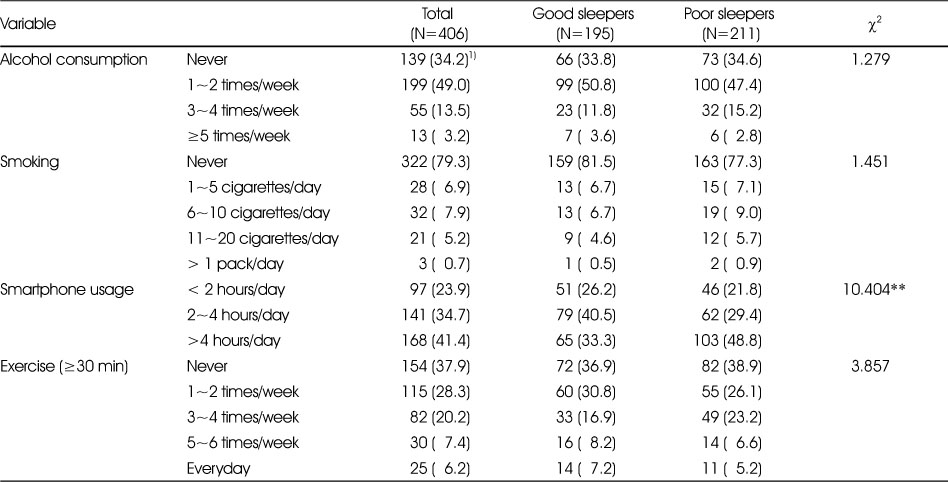Articles
- Page Path
- HOME > Korean J Community Nutr > Volume 24(5); 2019 > Article
-
Research Article
- Sleep Quality and Its Association with the Dietary Behavior and Lifestyle of University Students in Cheongju
-
Sewhan Jin
 , Munkyong Pae
, Munkyong Pae
-
Korean Journal of Community Nutrition 2019;24(5):395-407.
DOI: https://doi.org/10.5720/kjcn.2019.24.5.395
Published online: October 30, 2019
1Department of Food and Nutrition, Chungbuk National University, Cheongju, Korea, Student.
2Department of Food and Nutrition, Chungbuk National University, Cheongju, Korea, Professor.
- Corresponding author: Munkyong Pae. Department of Food and Nutrition, Chungbuk National University, 1 Chungdae-ro, Seowon-gu, Cheongju 28644, Korea. Tel: (043) 261-2745, Fax: (043) 267-2742, mpae@chungbuk.ac.kr
Copyright © 2019 The Korean Society of Community Nutrition
This is an Open-Access article distributed under the terms of the Creative Commons Attribution Non-Commercial License (http://creativecommons.org/licenses/by-nc/3.0/) which permits unrestricted non-commercial use, distribution, and reproduction in any medium, provided the original work is properly cited.
- 1,691 Views
- 18 Download
- 2 Crossref
Abstract
-
Objectives
- This study examined the association of the sleep quality and patterns with the dietary behavior, including snack and beverage consumption, taste preferences, as well as lifestyle of university students.
-
Methods
- The subjects were 406 university students in Cheongju, Korea, and the data were collected using a self-administered questionnaire. They were divided into two groups according to the Pittsburgh Sleep Quality Index (PSQI): good-quality sleepers (PSQI score ≤ 5) and poor-quality sleepers (PSQI score > 5). The data were analyzed using a χ2-test, independent t-test, and analysis of covariance using the SPSS 25.0 program.
-
Results
- Fifty-two percent of university students were categorized as poor-quality sleepers by the PSQI. Students classified as poor-quality sleepers had delayed bedtimes, and a shorter duration in bed and total sleep hours than the good-quality sleepers did. Poor-quality sleepers were more prevalent among those who were female, having irregular mealtimes, or frequent late night meals. They also consumed fast food frequently, such as fried chicken and hamburgers, and noodles when adjusted for gender. In addition, drinks with caffeine over milk were dominant among poor-quality sleepers. Furthermore, the preferences for spicy and salty tastes and longer smartphone usage were more prevalent in those with poor-sleep quality.
-
Conclusions
- These results showed that more than 50% of university students reported disturbed sleep and poor quality sleep was associated with less desirable snack consumption and taste preference, more smartphone usage, and others. Therefore, nutrition education program along with lifestyle changes promoting sufficient sleep are encouraged to provide for university students, particularly those who have poor sleep quality.
- 1. Kim SH, Min JW, Park BK. The effect of smartphone addiction and stress on sleep quality among university students. J Korea Acad Ind Coop Soc 2019; 20(4): 112-120.
- 2. Jang SY, Ju EY, Park KM, Seo S, Choi SJ, Lee CK. Association between sleep duration and obesity in young Korean adults. Korean J Obes 2016; 25(4): 207-214.Article
- 3. Buysse DJ, Reynolds CF, Monk TH, Berman SR, Kupfer DJ. The Pittsburgh Sleep Quality Index: A new instrument for psychiatric practice and research. Psychiatry Res 1989; 28(2): 193-213.ArticlePubMed
- 4. Mollayeva T, Thurairajah P, Burton K, Mollayeva S, Shapiro CM, Colantonio A. The Pittsburgh Sleep Quality Index as a screening tool for sleep dysfunction in clinical and non-clinical samples: a systematic review and meta-analysis. Sleep Med Rev 2016; 25: 52-73.ArticlePubMed
- 5. Kim HB, Park YW. Correlation between sleep quality and snack intake in third year middle and high school students in the Gwangju area. J Korean Soc Food Sci Nutr 2013; 42(2): 212-222.Article
- 6. Ro HL. Analysis of the relationship among sleep type and sleep quality, and perceived life stress in college students: Based on students living in a dormitory. J Korean Data Anal Soc 2017; 19(2): 1011-1024.Article
- 7. Park MJ, Chung MY. Quality of sleep and affecting factors according to gender in college students. J Digit Converg 2018; 16(9): 187-195.
- 8. Lee BI, Kim KM, Kim BM, Kim BM, Kim JE, Lee IH. Caffeine contained beverage intake and sleep quality of university students. J Korean Soc Sch Health 2014; 27(1): 31-38.Article
- 9. Sung MJ, Chang KJ. Correlations among life stress, sleep, anthropometric measurement and nutrient intakes of college students. J Korean Soc Food Sci Nutr 2007; 36(7): 840-848.Article
- 10. Kim SD, Kim MG. The relation of life style and quality of sleep in university students. J Korea Acad Ind Coop Soc 2013; 14(6): 2795-2801.Article
- 11. Kang SG, Yoon HK, Ham BJ, Choi YK, Kim SH, Joe SH. Effects of minor stressful events on sleep in college students. Sleep Med Psychophysiol 2002; 9(1): 48-55.
- 12. Yi H. Sleep quality and its associated factors in adults. J Korean Public Health Nurs 2013; 27(1): 76-88.Article
- 13. Kang YH, Kim MY, Lee GJ, Jung DY, Ma YW. A study of social support, loneliness, sleep quality, and perceived health status among community dwelling older adults. J Korean Public Health Nurs 2012; 26(2): 303-313.Article
- 14. Kim KH, Cho HS. Effect of sleep duration on dietary habits and body composition of university students. Korean J Food Cult 2013; 28(5): 539-546.Article
- 15. Spiegel K, Tasali E, Penev P, Van Cauter E. Brief communication: Sleep curtailment in healthy young men is associated with decreased leptin levels, elevated ghrelin levels, and increased hunger and appetite. Ann Intern Med 2004; 141(11): 846-850.ArticlePubMed
- 16. Kim CR, Song YM, Shin JY, Gim W. Association between sleep duration and impaired fasting glucose in Korean adults: results from the Korean National Health and Nutrition Examination Survey 2011-2012. Korean J Fam Med 2016; 37(1): 51-56.ArticlePubMedPMC
- 17. Hwang HR, Lee JG, Lee SY, Cha KS, Choi JH, Jeong DW. The relationship between hypertension and sleep duration: an analysis of the fifth Korea National Health and Nutrition Examination Survey (KNHANES V-3). Clin Hypertens 2015; 21(1): 8.ArticlePubMedPMCPDF
- 18. Lee SL, Lee SH. Survey on health-related factors, nutrition knowledge and food habits of college students in Wonju area. Korean J Community Nutr 2015; 20(2): 96-108.Article
- 19. Pae MK. Dietary habits and perception toward food additives according to the frequency of consumption of convenience food at convenience stores among university students in Cheongju. Korean J Community Nutr 2016; 21(2): 140-151.ArticlePDF
- 20. Kim MH, Kim H, Lee WK, Kim SJ, Yeon JY. Food habits and dietary behavior related to using processed food among male college students residing in dormitory and self-boarding in Gangwon. Korean J Community Nutr 2013; 18(4): 372-385.Article
- 21. Smith SL, Ludy M, Tucker RM. Changes in taste preference and steps taken after sleep curtailment. Physiol Behav 2016; 163: 228-233.ArticlePubMed
- 22. Patterson RE, Emond JA, Natarajan L, Wesseling-Perry K, Kolonel LN, Jardack P. Short sleep duration is associated with higher energy intake and expenditure among African-American and Non-Hispanic white adults. J Nutr 2014; 144(4): 461-466.ArticlePubMedPMC
- 23. Kim S, DeRoo LA, Sandler DP. Eating patterns and nutritional characteristics associated with sleep duration. Public Health Nutr 2011; 14(5): 889-895.ArticlePubMed
- 24. Kim SJ, Lyoo IK, Won CY, Jeong DU. Characteristics of sleep pattern among Korean college students. Sleep Med Psycophysiol 2006; 13(1): 15-21.
- 25. Sohn SI, Kim DH, Lee MY, Cho YW. The reliability and validity of the Korean version of the Pittsburgh Sleep Quality Index. Sleep Breath 2012; 16(3): 803-812.ArticlePubMedPDF
- 26. Korean Society for the Study of Obesity. Guideline for treatment of obesity. Seoul: Korean Society for the Study of Obesity; 2012. p. 17-21.
- 27. Kim SD, Kim MG. The relation of life style and quality of sleep in university students. J Korea Acad Ind Coop Soc 2013; 14(6): 2795-2801.Article
- 28. Seo JS, Lee JH, Lee KK. Lifestyle and health state in individuals with frequent nocturnal sleep interruption. J Korean Acad Fam Med 2006; 27(12): 967-974.
- 29. Kim MH, Jeong ES, Kim EJ, Cho HK, Bae YJ, Choi MK. Night eating status of university students in partial area of Chungnam. J East Asian Soc Dietary Life 2011; 21(4): 563-576.
- 30. Baron KG, Reid KJ, Kern AS, Zee PC. Role of sleep timing in caloric intake and BMI. Obesity 2011; 19(7): 1374-1381.ArticlePubMedPDF
- 31. Hong JH, Kim SY. Correlation between eating behavior and stress level in high school students. J Korean Soc Food Sci Nutr 2014; 43(3): 459-470.Article
- 32. Kim MH, Kim H, Lee WK, Kim SJ, Yeon JY. Food habits and dietary behavior related to using processed food among male college students residing in dormitory and self-boarding in Gangwon. Korean J Community Nutr 2013; 18(4): 372-385.Article
- 33. Kim TY, Kim SM, Kim JY, Im JY, Yu H, Han YH. Awareness and consumption of energy drinks and associated factors among college students in Cheongju. Korean J Community Nutr 2018; 23(1): 60-72.ArticlePDF
- 34. Lv W, Finlayson G, Dando R. Sleep, food cravings and taste. Appetite 2018; 125: 210-216.ArticlePubMed
- 35. Szczygiel EJ, Cho S, Snyder MK, Tucker RM. Associations between chemosensory function, sweet taste preference, and the previous night's sleep in non-obese males. Food Qual Preference 2019; 75: 105-112.Article
- 36. Lee KA. Salt-related dietary behaviors of university students in Gyeongbuk area. J Korean Soc Food Sci Nutr 2014; 43(7): 1122-1131.Article
- 37. Kang MJ, Choi KB, Lyu ES. Differences in sodium-intake related dietary behaviors and correlation analysis according to salty taste preference of university students in Busan area. Korean J Food Cook Sci 2015; 31(4): 477-484.Article
- 38. Lee BI, Kim SW, Kim YJ, Bae JY, Woo SK, Woo HN. The relationship between smartphone usage time and physical and mental health of university students. J Korean Soc Sch Health 2013; 26(1): 45-53.
- 39. Jung MS, Ju KO, Song MS, Lee KS. Effects of smartphone overuse on perceived cognitive function, fatigue, and daytime sleepiness among college students. J Korean Soc Sch Health 2016; 29(3): 245-255.Article
- 40. Park SY. The correlations between a sleep quality and a healthrelated quality of life according to a adult smart phone use time. J Next Gener Converg Tech Assoc 2018; 2(4): 181-188.Article
- 41. Kim SH, Min JW, Park BK. The effect of smartphone addiction and stress on sleep quality among university students. J Korea Acad Ind Coop Soc 2019; 20(4): 112-120.
- 42. Van den. Adolescent use of mobile phones for calling and for sending text messages after lights out: results from a prospective cohort study with a one-year follow-up. Sleep 2007; 30(9): 1220-1223.ArticlePubMedPMC
- 43. Crum RM, Storr CL, Chan YF, Ford DE. Sleep disturbance and risk for alcohol-related problems. Am J Psychiatry 2004; 161(7): 1197-1203.ArticlePubMed
- 44. Roehrs T, Roth T. Sleep, sleepiness, sleep disorders and alcohol use and abuse. Sleep Med Rev 2001; 5(4): 287-297.ArticlePubMed
- 45. Cho SB, Lee SH. Sleep disorder and alcohol. Sleep Med Psychophysiol 2017; 24(1): 5-11.
- 46. Kim MG, Kim SD. The effect of smoking behavior on sleep quality in university students. J Korea Acad Ind Coop Soc 2018; 19(3): 346-352.
REFERENCES
PSQI sleep quality

1) Mean ± SD
2) Duration in bed (h)=Rise times - Bedtimes
3) N(%)
4) If sum is equal 0=0; 1~2=1; 3~4=2; 5~6=3
5) If sum is equal 0=0; 1~9=1; 10~18=2; 19~27=3
6) Pittsburgh Sleep Quality Index (PSQI) score was achieved by adding the seven component scores together.
*: p<0.05, ***: p<0.001 by independent t-test or chi-square test
Figure & Data
REFERENCES
Citations

- Relationship of sleep quality, BMI, Dietary, and socioeconomic attributes among young adults: A systematic review
Seohyun Ahn, Wan Safwani Binti Wan Kamarul Zaman, Sim-Kuan Goh, Chow-Khuen Chan
Journal of Health Psychology.2025;[Epub] CrossRef - Health Behaviors and Dietary Habits according to Sleep Duration in Korean Adults Based on the 2013–2015 Korea National Health and Nutrition Examination Survey
Jin-A Kim, Sim-Yeol Lee
Korean Journal of Health Promotion.2019; 19(4): 237. CrossRef
General characteristics of subjects
1) N (%)
2) Body mass index
**: p<0.01 by chi-square test
PSQI sleep quality
1) Mean ± SD
2) Duration in bed (h)=Rise times - Bedtimes
3) N(%)
4) If sum is equal 0=0; 1~2=1; 3~4=2; 5~6=3
5) If sum is equal 0=0; 1~9=1; 10~18=2; 19~27=3
6) Pittsburgh Sleep Quality Index (PSQI) score was achieved by adding the seven component scores together.
*: p<0.05, ***: p<0.001 by independent t-test or chi-square test
Dietary habits of subjects by PSQI sleep quality
1) N (%)
*: p<0.05 by chi-square test
The most favorite late night meals by PSQI sleep quality
1) Except for the subjects who answered never for eating late night meal
2) N (%)
Frequency of snack consumptions by PSQI sleep quality
1) Mean ± SD
2) Weekly consumption frequency
***: p<0.001 by independent t-test, #: p<0.05, †: p<0.001 by ANCOVA when adjusted for gender
Frequency of drink consumptions by PSQI sleep quality
1) Mean ± SD
2) Weekly consumption frequency
3) Calculated by subtracting the frequency of milk consumption from those of coffee, tea, and energy drink.
*: p<0.05 by independent t-test, #: p<0.05 by ANCOVA when adjusted for gender
Taste preferences by PSQI sleep quality
1) Mean ± SD
2) 5-point Likert scale from 1 (strongly dislike) to 5 (strongly like)
*: p<0.05, **: p<0.01 by independent t-test, #: p<0.05 by ANCOVA when adjusted for gender
Health-related lifestyles of subjects by PSQI sleep quality
1) N (%)
**: p<0.01 by chi-square test
1) N (%) 2) Body mass index **: p<0.01 by chi-square test
1) Mean ± SD 2) Duration in bed (h)=Rise times - Bedtimes 3) N(%) 4) If sum is equal 0=0; 1~2=1; 3~4=2; 5~6=3 5) If sum is equal 0=0; 1~9=1; 10~18=2; 19~27=3 6) Pittsburgh Sleep Quality Index (PSQI) score was achieved by adding the seven component scores together. *: p<0.05, ***: p<0.001 by independent
1) N (%) *: p<0.05 by chi-square test
1) Except for the subjects who answered never for eating late night meal 2) N (%)
1) Mean ± SD 2) Weekly consumption frequency ***: p<0.001 by independent
1) Mean ± SD 2) Weekly consumption frequency 3) Calculated by subtracting the frequency of milk consumption from those of coffee, tea, and energy drink. *: p<0.05 by independent
1) Mean ± SD 2) 5-point Likert scale from 1 (strongly dislike) to 5 (strongly like) *: p<0.05, **: p<0.01 by independent
1) N (%) **: p<0.01 by chi-square test

 KSCN
KSCN







 Cite
Cite


